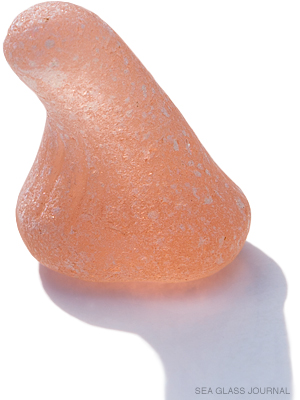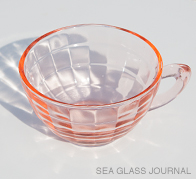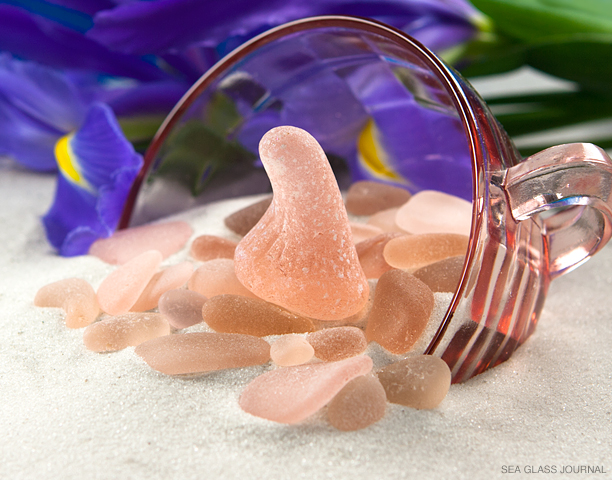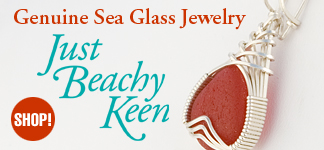The Sea Glass Shard of the Month: February 2014
Pink Depression Glass Pitcher Handle Segment

Sea Glass Specifications:
Color: Salmon Pink
Max Length: 33.8 mm (1.33")
Max Width: 29.2 mm (1.15")
Weight: 21.8 grams (0.77 oz)
Estimated Age: Between 70 to 80 Years
For the month of February we are featuring a salmon pink colored handle segment from a depression era water pitcher. Depression glass is a term used for the inexpensive glassware manufactured from the late 1920s through the 1950s, but most prominently in the 1930s during the height of the Depression, hence the term given by collectors to describe this type of glassware.

Pictured is an Anchor Hocking Pink Block Optic Teacup produced in the 1930s.
Facts of Interest
Elegant glass, often confused with the more common Depression glass, is higher quality glassware created in the United States during the Depression Era.
There is a national society dedicated to Depression Era glassware. See their online site at National Depression Glass Association.
During the economic downturn of the Depression the need for inexpensive glassware was fulfilled by the mass production of machine-pressed glass products, often using pattern molds, producing glass in a variety of transparent, pastel colors including pink, yellow, blue and clear along with other less common colors as well.
A complete setting could be purchased for two or three dollars being sold in retail stores as well as mail-order catalogs.[1] Tableware of this type was also given away as promotional items in soap or cereal boxes, or might be given away at movie houses or gas stations to encourage patronage.
"Tableware of this type was also given away as promotional items in soap or cereal boxes..."
To collectors of this type of glassware there are two distinct classes: "Elegant Glass" and "Depression Glass". What is commonly referred to as Depression glassware, being made by over 20 companies, often had little or no hand finishing or treatments once it came out of the mold. There is also Elegant glass, often confused with the cheaper Depression glass, manufactured by a small number of companies which also included a great deal of hand finishing after coming out of the mold to remove seam lines and other imperfections to produce a much more elegant piece of glassware.[2]
As stated in the introduction, our featured sea glass specimen probably came from a salmon pink colored water pitcher. The color of this type of depression glass came about by the introduction of selenium dioxide into glass melt. Selenium dioxide was used as a glass decolorizer, much like manganese dioxide was used up through World War I. Selenium was the best decolorizer for glass made in open glass tanks (versus the earlier closed pots) which was used with most all automatic bottle machines.[3]
As with the amethyst sun-coloring of glass contain manganese dioxide, decolorized glass containing selenium can react with UV exposure to produce tints of straw, pink or grey depending on many factors including the types of compounds used in conjunction with the selenium in the manufacturing process.
Depression glass has been gaining popularity as a collectible item as indicated by the advent of such organizations as the National Depression Glass Association[4]. It has also gained popularity among sea glass collectors as well, not only for the beautiful pastel colors and patterns that the sea glass gems have, but also because it is easily dated and the glassware origins of these shards can often be traceable.
We would encourage any sea glass enthusiast to go through their own collection again to see if it includes any of this type of glassware. If so, you may be successful in determining its origins by researching the many sites online dedicated to Depression glassware.
REFERENCES:
1. http://www.depression-glass-antiques.com
2. http://www.ndga.net-articles-whatisdg
3. http://www.sha.org/bottle/colors.htm
4. Pure Sea Glass, Richard LaMotte

Keep up-to-date on all things sea glass... like us on Facebook!
Sea Glass Journal on Facebook






